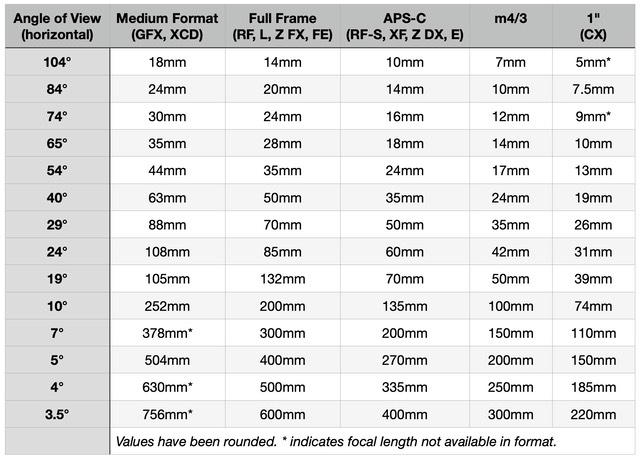I see a lot of posts and comments about focal length, in particular zoom ratios of lenses (also called the zoom factor). With a number of recent wide angle lenses (e.g. 11-16mm f/2.8 APS/DX), sometimes these comments get really out of whack with reality. Someone recently commented about one of these wide angle zooms with the words “what is there, a contest to make the lens with least amount of usable focal length range?” That person is showing their ignorance. Indeed, one wonders whether they would ever shoot with any prime, which is, after all, a zoom lens with a zoom factor of 1.
It doesn’t help that the camera makers have long been in a game of X wars. As in 4x, 10x, and now with the Coolpix P1000, 125x optical zoom! I put the exclamation point there as I’m starting to see product marketing with an exclamation point after the optical zoom range ;~).
But focal length isn’t truly a revealing statistic. A 2x zoom at wide angle can be quite different than a 2x zoom at telephoto in the variability of imagery you can create with it.
Let’s look at a chart for a moment (I’ll use a version of one that’s been on my sansmirror.com site since the beginning). The truly important thing to pay attention to here is angle of view (note DSLR DX and FX are the same as Z DX and FX; I’m repurposing a chart from another of my sites):

One of the most restrictive of the current wide angle zooms is the 11-16mm f/2.8 APS/DX. It doesn't even reach a zoom factor of 2x (pity the poor marketing team having to deal with that! ;~). But that 11-16mm on the crop sensor body it’s intended for gives you angle of view differences of about 20 degrees. That’s a pretty significant differential. But just as important is the perspective change. If I frame a person fully at 14mm I’m at about 3.5 feet. If I frame that same person fully at 20mm I’m closer to 5 feet. My perspective is changing fairly considerably.
One of the dangers in dismissing zoom lenses with modest zoom ratios is that you’re essentially saying “it doesn’t replace enough prime lenses.” But is that true? Actually, a 14-20mm f/2 DX would replace three large available prime Nikkors: the 14mm f/2.8, the 18mm f/2.8, and the 20mm f/1.8 (or f/2.8) (if you want to think in FX terms, it would be more like replacing a 20mm, 24mm, and 28mm prime lens set with one lens). Sure, the Coolpix P1000 replaces more than a dozen prime lenses, but realistically, how many primes do some other common zooms replace? For example, the 24-70mm: four, best case (24mm, 35mm, 50mm, 70mm, though this latter focal length isn’t a current Nikkor prime offering). Heck, how about the 18-140mm DX? Seven (in FX equivalents: 28mm, 35mm, 50mm, 85mm, 105mm, 135mm, 180/200mm). That’s a super zoom, and it truly replaces seven prime lenses in your kit.
So why the complaints about only replacing three? Because the posters are paying attention to the wrong number, basically. Moreover, when you zoom only a little bit you’re keeping perspective fixed and changing your cropping slightly. Most of these complaints about lack of zoom ratio are convenience complaints from people not controlling all photographic variables in traditional ways. Moreover, they may not be using tools that are already available to them.
For example, let’s say I’m off in Africa with my D850 and 500mm lens. Would I rather that it was a 500-750mm zoom so I can handle crops when I can’t quite get as close to an animal as I want? Funny thing is, that combo actually is a 500-750mm zoom. Say what? 500mm at FX, 600mm equivalent at 1.2x image area crop, 750mm equivalent at 1.5x image area crop. I’ve got Image Area Crop set to my function button so that’s almost as convenient as a zoom ring, I’m just using my right hand instead of my left.
But wait, I’m losing pixels. Well, that’s the great thing about the D850, and one of the reasons why I’ve consistently called it the best all-around DSLR available during its reign as Nikon’s highest resolution body: I’ve got 45mp at FX (500mm), 30mp at 1.2x (600mm), ~20mp at 1.5x/DX (750mm). I’ll remind people that prior to the D800 coming out in 2012, my best body was 24mp and most of my wildlife images were actually shot at 12mp.
So don’t get overly hung up on zoom factor numbers. Look instead what a lens is actually going to do for you in practice. In practice, virtually every wide angle lens zoom currently made (10-24mm, 11-16mm, 14-20mm, 14-24mm, 16-35mm, etc.) is replacing three or more of the prime lenses I would have carried without the zoom. My only issue is with whether I’m losing too much image quality with the zoom construction compared to the prime, not the size of the zoom factor.
Since I know someone will ask, the reason why the 11-16mm is in my DX kit and the 14-24mm is in my FX kit is very simple: both those lenses replace three primes for me, just different ones. I don’t feel I’m actually sacrificing anything in terms of optical quality, either. Indeed, both of those lenses are in my opinion better optically than the Nikkor 14mm f/2.8 and 18mm f/2.8, two of the lenses I'm duplicating.
